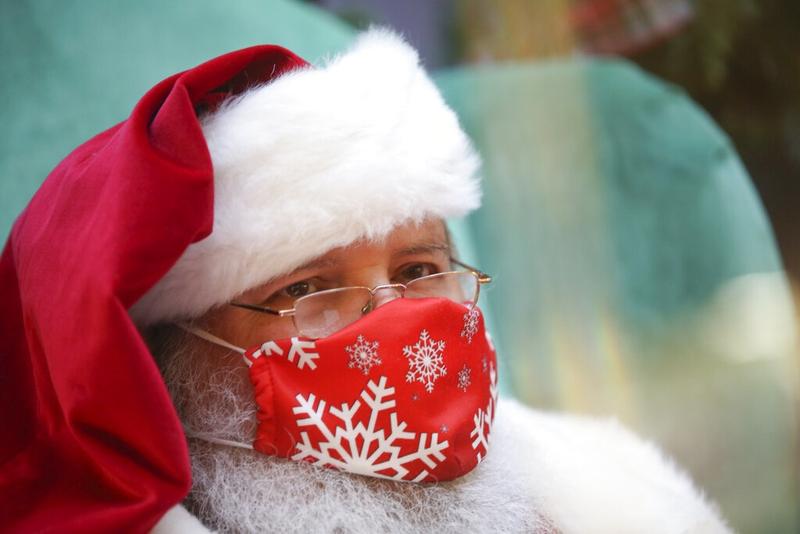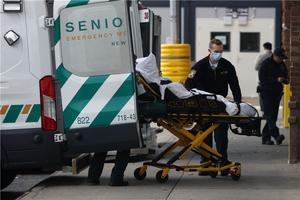COVID catching up to small facilities once largely exempt
 Santa Claus sits behind plexiglass and wears a mask as he waits for children in the Viewmont Mall in Scranton, Pennsylvania, Dec 9, 2020. (JAKE DANNA STEVENS/THE TIMES-TRIBUNE VIA AP)
Santa Claus sits behind plexiglass and wears a mask as he waits for children in the Viewmont Mall in Scranton, Pennsylvania, Dec 9, 2020. (JAKE DANNA STEVENS/THE TIMES-TRIBUNE VIA AP)
In Childress, Texas, people with COVID-19 symptoms seeking treatment at the local hospital are asked to wait in their cars when possible.
"They're either stacking up in the waiting room or out in the parking lot," said Holly Holcomb, chief operating officer for the Childress Regional Medical Center, adding that her six-bed emergency room has been stretched to the limit.
We’re competing with the entire country. Every state is on fire with the COVID surge
Rich Rasmussen, president of the Montana Hospital Association
A man who arrived at the emergency room in October did not have COVID-19. However, his serious abdominal condition required surgery, hospital administrators told The Texas Tribune.
He waited more than nine hours in the emergency room while doctors called eight larger hospitals to see if they could perform the surgery, Holcomb said. They declined to accept the patient and the man died, the Tribune reported.
"I've been here 24 years and I don't ever remember not being able to transfer a patient out," said Holcomb, whose hospital in the town of about 6,900 is near the Oklahoma border.
The COVID-19 pandemic raging across the United States is overwhelming many hospitals, large and small, but especially the latter.
When the first wave of cases hit the country in March, rural communities were left largely unscathed.
The "beast", as New York Governor Andrew Cuomo called it, had made his state its epicenter.
 A COVID-19 patient receives treatment at a hospital in Houston, Texas. (PHOTO PROVIDED TO CHINA DAILY)
A COVID-19 patient receives treatment at a hospital in Houston, Texas. (PHOTO PROVIDED TO CHINA DAILY)
Elmhurst Hospital in Queens, New York City, made headlines nationwide with stories of numerous deaths and photographs of bodies being placed in refrigerated trucks.
In March and April, "everyone was watching in horror what was happening in New York City and New Orleans, but that never seemed to arrive in rural America", said Brock Slabach, senior vice-president of the National Rural Health Association, according to the Fierce Healthcare website. "Over the summer, we thought perhaps rural areas were exempt from the impact of COVID-19."
With some exceptions, they were. In summer, the disease spread to suburban communities and ravaged the Sun Belt, which stretches across the south of the country from Florida to California. Rural areas again appeared to be free from the disease.
This is no longer the case.
The pandemic raging across the country is overwhelming hospitals of all sizes. The already-frayed healthcare safety net in rural areas is under attack from a "fall wave" of COVID-19 cases that has gone from bad to worse.
Nationwide, healthcare experts expect the latest wave to last until at least next month, surpassing the two previous ones in terms of the number of cases, hospitalizations and deaths.
Of the first 100,000 COVID-19 deaths in the US, about one-fifth occurred outside of urban areas. Nearly half of the second 100,000 deaths were among non-urban residents, according to an analysis by National Public Radio.
Slabach said the nation is now seeing higher mortality numbers in rural areas as the proportion of deaths in mid-size cities and rural communities rises.
Rural populations are often older, sicker and poorer than those in urban areas and have reduced access to physical and mental healthcare. This likely means that more rural residents infected with COVID-19 during this wave of cases will end up in hospitals.
 An ambulance transfers a COVID-19 patient in New York. (PHOTO PROVIDED TO CHINA DAILY)
An ambulance transfers a COVID-19 patient in New York. (PHOTO PROVIDED TO CHINA DAILY)
Small-town doctors report having to keep seriously ill patients in emergency rooms and ambulances for hours because of bed shortages in intensive care units at larger hospitals.
The shortage of beds, and especially staff members, is the new normal. More than 1,000 hospitals across the US reported critical shortages of employees in recent days, according to the Department of Health and Human Services.
Many rural hospitals said they have had to look for specialty care hundreds of kilometers away, sometimes across state lines. However, larger hospitals are often overwhelmed by COVID-19 cases, leaving smaller facilities unable to transfer their most gravely ill patients to higher levels of care.
Staff shortages have meant hospitals across the country-including some in rural areas-are seeking traveling doctors and nurses. Hefty paychecks are being offered to nurses willing to move for their work.
In Sioux Falls, South Dakota, nurses can make more than US$6,200 a week. A recent posting for a job in Fargo, North Dakota, offered more than US$8,000, while some nurses can earn as much as US$10,000 a week.
One of the country's largest healthcare staffing companies, Aya Healthcare, based in San Diego, California, recently sent 300 traveling clinicians to rural hospitals, and is trying to meet demand for 1,300 more.
April Hansen, a vice-president of the company, said, "We've had full crews working nearly 24/7, seven days a week."
 A medical worker pauses after taking a COVID-19 patient to a newly opened field hospital in Rhode Island on Dec 1, 2020. (DAVID GOLDMAN / AP)
A medical worker pauses after taking a COVID-19 patient to a newly opened field hospital in Rhode Island on Dec 1, 2020. (DAVID GOLDMAN / AP)
Competing for talent
In Montana, the number of COVID-19 cases has surged in recent weeks, with more than 1,000 new infections often reported each day. Over 100 traveling nurses and respiratory therapists arrived last month to help ease staff shortages at hospitals overwhelmed by the disease.
Rich Rasmussen, president of the Montana Hospital Association, told MTN News that a total of 278 additional nurses and respiratory therapists would arrive on a contract with NuWest Group of Bellevue, Washington.
"We're competing with the entire country. Every state is on fire with the COVID surge. Everyone is scrambling to get more workers into their respective states, so we're competing with that exact, same talent," Rasmussen said.
The governor's office in Montana said the state arranged the contract with NuWest and would shoulder the cost through Dec 31, but may be eligible for reimbursement by the Federal Emergency Management Agency. The cost should ultimately be covered by the agency and federal COVID-19 relief funds, the office said.
Rasmussen said major hospitals in Montana have been overwhelmed not only by COVID-19 patients, but also by shortages of staff members, as so many healthcare workers have either contracted the virus or been in contact with someone who has, requiring them to be quarantined.
However, healthcare officials said traveling nurses threaten to shift the supply toward more-affluent areas, leaving rural and urban public hospitals short-staffed as the pandemic worsens.
"That is a huge threat," said Angelina Salazar, CEO of the Western Healthcare Alliance, a consortium of 29 small hospitals in rural Colorado and Utah.
Most rural hospitals cannot afford high payments for traveling nurses, and even if they could, rural communities in states with extreme weather conditions in winter are not as attractive as other areas for them.
 A pedestrian passes empty dining booths in Los Angeles County after new restrictions on gatherings were imposed in the area on Nov 30, 2020. (PHOTO / XINHUA)
A pedestrian passes empty dining booths in Los Angeles County after new restrictions on gatherings were imposed in the area on Nov 30, 2020. (PHOTO / XINHUA)
Tim Blasl, president of the North Dakota Hospital Association, said: "When you get into the winter season, does it become maybe more of a challenge? It could."
John Henderson, chief executive of the Texas Organization of Rural and Community Hospitals, said fewer than half the rural hospitals in the state perform surgeries or deliver babies. As urban hospitals fill up, this puts pressure on smaller facilities to find beds for patients in crisis.
"When you're a small, rural, isolated hospital and you have a patient that exceeds not just your staffing capability but your scope of services capability, that becomes really hard," Henderson said.
Most rural hospitals are not equipped to handle the most serious COVID-19 cases. Many do not have intensive care units or enough doctors and other staff members to cope with multiple patients who require such care. This means that these patients have to be transferred to bigger hospitals.
Robert Hancock, a doctor working at several hospitals in Texas and Oklahoma, and also president of the Texas College of Emergency Physicians, said one of these hospitals recently admitted a patient with COVID-19 and many other medical problems who needed specialized care.
"We called every hospital in Oklahoma that had the capability we needed and every hospital system in Dallas-Fort Worth, Little Rock, Lubbock, Amarillo and Wichita Falls," Hancock said.
"Over about an eight-hour period, we got told 'no' by everybody. We wound up having to keep the patient and just do the best we could with the resources we had."
With winter arriving, the threat of snow, icy roads and the flu season-coupled with rising infections-could worsen an already bad situation in many states.
Administrators said efforts by hospitals to handle the pandemic and slow its spread have meant a trade-off-the cancellation of elective surgeries, one of the hospitals' most lucrative income streams-which threatens to hasten the closure rate for small hospitals.
Alan Morgan, head of the National Rural Health Association, recently told Kaiser Health News that if the short-term cash needs of rural hospitals were not addressed, hundreds of them would close before the pandemic ended.
Henderson said cash-strapped hospitals in rural Texas are having to make layoffs in order to pay their employees.
Well before the latest surge in COVID-19 infections, the profitability of rural healthcare had collapsed nationwide due to a combination of narrowing Medicare reimbursement and more patients lacking any other form of health insurance, as they were unemployed. More than 120 rural hospitals have been forced to close over the past decade, according to state hospital associations.
Perfect storm
Hospitals in small towns, like their counterparts in large US cities, rely heavily on moneymakers such as elective surgeries, physical therapy and laboratory tests, but according to the Chartis Center for Rural Health, based in Chicago, almost half of them still operate in the red.
Robin Rau, CEO of Miller County Hospital in Georgia, said: "This virus, and what it is causing for these hospitals, is the perfect storm that will close the hospitals at a time this country critically needs them."
Michael Purvis, CEO of Candler County Hospital in Metter, Georgia, said he is already seeing negative cash flow. The number of patients coming to his hospital for profitable outpatient procedures has dropped by half, as they have canceled their surgeries, MRI scans and physical therapy.
Julie Jones, CEO of Community Hospital-Fairfax in Missouri, said she has to pay about US$5 each for N95 respirator masks that offer crucial protection for her front-line workers. The usual cost is 30 cents.
Angela Ammons, CEO of Clinch Memorial Hospital in Homerville, Georgia, said she has warned staff members that if hand sanitizer and disinfecting wipes continue to go missing, she will watch the video footage and immediately fire anyone caught stealing supplies. She is so worried about running out of protective equipment, she is asking employees who have sewing machines to make cotton masks.
The National Rural Health Association, along with many rural hospital executives, is lobbying the federal government for immediate cash assistance, no-interest loans and Medicare reimbursement adjustments.
However, many rural hospital CEOs are concerned that assistance may come too late.


